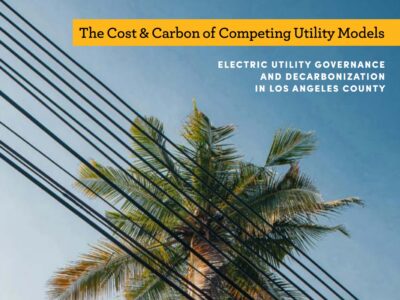Tariffs and Clean Energy: What You Need to Know
The effect of tariffs on energy markets is complex, and a lot depends on the details.
“Tariffs are the most beautiful word to me,” enthuses Donald Trump. The tariffs on Mexico, Canada, and China that he imposed today may well turn out to be the policies with the largest impact on the economy, including energy markets. They could hold back clean technology in the U.S, as well as harming other industries. But a lot depends on the details and the responses of exporting countries.
The Economics of Tariffs
Economists generally believe that tariffs are partly or entirely passed on to consumers, just like sales taxes. For instance, a government study found “nearly dollar for dollar passthrough” for Trump’s earlier steel and aluminum tariffs. This may be particularly true until supply chains can reorganize, and may be less true for some industries than others.
Economists also generally think the net impact of the Trump tariffs on the economy will be negative. A report by the non-partisan Tax Foundation estimates that “the 25 percent tariffs on Canada and Mexico and 10 percent tariffs on China proposed to go into effect as early as February 1, 2025, would shrink economic output by 0.4 percent and increase taxes by $1.2 trillion between 2025 and 2034.” The report also found that consumer prices for some household products would rise significantly.
Trump seems to think tariffs are a freebie, with no effects on domestic markets because the economic burden falls entirely on exporting countries. If so, clean tech industries have nothing to worry about. But as I said, economists aren’t so sanguine, so let’s assume he’s wrong and that tariffs get passed on to US firms and consumers.
Before we turn to impacts on clean energy, one point is worth noting at the outset. Reductions in trade with the US may free up capacity that can be redirected to sales elsewhere. For instance, if China cannot sell as many battery components in the U.S., it is likely to increase sales to other countries. Thus, although US emissions reductions could be slowed due to Trump’s tariffs, this effect could be offset somewhat by increased use of clean energy technologies elsewhere.
This is the flipside of the argument that restricting U.S. oil production results in increased production elsewhere to fill the gap. Here, decreased U.S. consumption of clean technologies promotes increases in consumption elsewhere. In both situations, however, the substitution is not one for one.
Impacts on US Clean Energy
North American tariffs. Tariffs on Mexico and Canada will have their greatest impact on wind turbines, which require a lot of steel. These tariffs would also impact new transmission lines, which could reduce grid stability. In addition, these tariffs are expected to severely impact the U.S. car industry, including conventional vehicles, because a lot of automotive components crisscross borders. For the same reason, the cost of car repairs would go up.
China tariffs. Punitive tariffs on China could dent the boom in other clean technologies. They would impact solar, especially if they extended to Southeast Asian firms who sometimes act as conduits for Chinese components. But there are now quite a few U.S. producers, which would presumably ramp up.
Battery storage would be more heavily impacted because China is currently the source of about three-quarters of battery components. They are so cheap that they would remain competitive even with a substantial tariff, but costs would increase for consumers. Price increases for batteries would also impact EV sales.
Today’s 10% tariffs on China are probably too small to have a major impact, especially given the price advantage they have over the competition.
Impacts on US Fossil Fuel Production and Use
Everything is relative, and the impact on clean energy will also depend on how tariffs impact fossil fuel production and use. That would not be a negligible effect. That’s why the American Petroleum Institute opposed Trump’s tariffs on steel and aluminum in his first term. For instance, higher steel prices impact pipeline costs substantially. As I mentioned earlier, these tariffs would also raise car prices significantly, reducing purchases of new gas and diesel vehicles. Some sophisticated refinery components come from China, which could cause problems if they become unavailable.
The tariffs will include imported oil, though at a lower rate of 10%, although the industry had already warned of the impact on consumer prices. Gas prices will rise in parts of the country. Tariffs could also lead to a stronger dollar, which would impact US oil exports.
Uncertainties
International trade economics is complicated, and we can’t be certain of how tariffs will work out, particularly in the long term when economies have fully adjusted to them. Trump’s hope is that the tariffs will cause a boom in U.S. production, although there is also evidence that protected industries are less efficient and innovative, resulting in higher consumer prices. In the 19th Century, which Trump touts as a golden age brought on by U.S. tariffs, the evidence suggests that they did little to promote economic growth. Indeed, they may have made U.S. businesses weaker rather than stronger.
It’s also possible that this will turn out to be a tempest in a teapot. Investors had been assuming that the threat of tariffs was simply a negotiating ploy and that any tariffs will end quickly as a result. There are reasons to doubt this optimistic scenario. House Republicans are reportedly planning to count the tariffs as revenue to use for offsetting new spending in their new reconciliation bill. That only works if the tariffs are going to be around for quite some time. [Note: on Monday, Trump agreed to one-month deferrals of the tariffs on Canada and Mexico, which may be a sign that he is willing to negotiate or that the adverse market reaction to the tariffs is making him back off.]
Also, Trump said on Friday that he was planning further tariffs on semiconductor chips, pharmaceuticals, steel and aluminum and oil and gas. He’s also said that he was not making any specific demands in connection with tariff increases. So it looks like he’s deadly serious about cutting off American consumers and manufacturers from foreign suppliers.
As the saying goes, it’s an ill-wind that blows no one good. At least one group of Americans will benefit from Trump’s trade policies: economists themselves.
The one thing that’s certain is that economists will get lots of publications from research into this episode of U.S. trade policy. Yet given the sheer amount of economic disruption Trump will be causing, they may find it hard to tease out the effects of specific measures like this initial round of tariffs.
Reader Comments
One Reply to “Tariffs and Clean Energy: What You Need to Know”
Comments are closed.






Question: how can Trump’s policies be more subversive than Clinton/Obama’s or more stupid than Biden’s? Impossible.